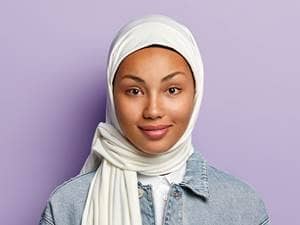
shutterstock.com
Muslim women who choose to cover their heads—and not all Muslim women do—generally make this decision for a variety of reasons. For many Muslim women, covering their head is a way to demonstrate their submission to God, and publicly identify as a religious woman. The decision by a Muslim woman to cover her head is often personal. Some Muslim women cover their heads as a form of cultural solidarity, or as a way to identify with the Muslim community. This is because, while the decision by a Muslim woman to cover her head has often been a decision motivated by religious feeling, the symbolism of covering one’s head has taken on new power in the modern era. In some countries where Muslim women have been encouraged to not cover their heads, or where the decision to cover one’s head has been promoted as strange or regressive, some Muslim women choose to cover their heads in order to challenge ideas about what religious practices are considered progressive, and which are considered problematic. For other Muslim women, covering one’s hair is simply the norm in their community, and not a decision that feels particularly heavy with meaning or symbolism.
For many Muslim women, covering their head is understood to be a religious obligation. There is no stated obligation in the Quran for a woman to cover her head, though there are several verses that promote women dressing modestly, and describe practices to keep men and women from immodestly encountering one another. Nonetheless, the choice to cover one’s head has become a very standard religious decision throughout much of the Muslim world. There are several references in the Quran and other scriptures of the Muslim faith that describe how the wives of the Prophet Muhammed would be separated by a veil, so they could be present without having to change their dress, and these textual references have become the basis for many to argue that Muslim women should cover their heads in public. (Other scholars suggest that such practices might have only been in place for the wives of the Prophet).
There are many different ways for Muslim women to cover their heads. The headscarf, niqab, al-Amira, shayla, khimar, burka, dupatta, and chador are the most common forms. Each of these methods of covering one’s head tend to be more pronounced in different countries and cultures. Some Muslim women choose to only cover their hair, or loosely cover their neck and shoulders. Other Muslim women choose to cover their heads and almost the entirety of their bodies, and even sometimes their faces. Many Muslim women will cover their heads in a variety of fabrics and colors.
When many people think about Muslim women covering their hair, they tend to use the word ‘hijab’, The term ‘hijab’ actually refers to a wide range of behaviors and actions, and for some Muslim women, the choice to cover their hair is part of a larger choice to live a life of modesty and religious values, where covering their head is just one manifestation of this lifestyle. For Muslim women, the decision to cover one’s head can be an ongoing one, or a decision that changes with circumstances on a regular basis.
To learn more about Islam, click here.
For many Muslim women, covering their head is understood to be a religious obligation. There is no stated obligation in the Quran for a woman to cover her head, though there are several verses that promote women dressing modestly, and describe practices to keep men and women from immodestly encountering one another. Nonetheless, the choice to cover one’s head has become a very standard religious decision throughout much of the Muslim world. There are several references in the Quran and other scriptures of the Muslim faith that describe how the wives of the Prophet Muhammed would be separated by a veil, so they could be present without having to change their dress, and these textual references have become the basis for many to argue that Muslim women should cover their heads in public. (Other scholars suggest that such practices might have only been in place for the wives of the Prophet).
There are many different ways for Muslim women to cover their heads. The headscarf, niqab, al-Amira, shayla, khimar, burka, dupatta, and chador are the most common forms. Each of these methods of covering one’s head tend to be more pronounced in different countries and cultures. Some Muslim women choose to only cover their hair, or loosely cover their neck and shoulders. Other Muslim women choose to cover their heads and almost the entirety of their bodies, and even sometimes their faces. Many Muslim women will cover their heads in a variety of fabrics and colors.
When many people think about Muslim women covering their hair, they tend to use the word ‘hijab’, The term ‘hijab’ actually refers to a wide range of behaviors and actions, and for some Muslim women, the choice to cover their hair is part of a larger choice to live a life of modesty and religious values, where covering their head is just one manifestation of this lifestyle. For Muslim women, the decision to cover one’s head can be an ongoing one, or a decision that changes with circumstances on a regular basis.
To learn more about Islam, click here.
1/26/2024 7:27:38 PM







